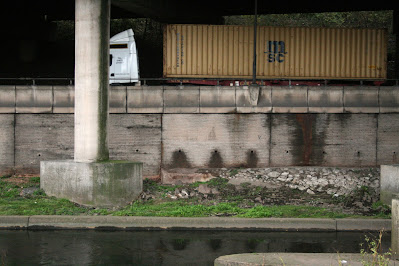Tame Way Markers: The Pimple
A walk along the River Tame from Castle Bromwich to (eventually) it's source, with several detours.
One of Birmingham's lesser-known accomplishments is that it is home to Britain's longest viaduct. Such an achievement might be ironically celebrated elsewhere, but Birmingham generally ignores such peculiar distinctions. The structure is not elegant, it is not beautiful and, with the passage of over fifty years since it was erected in concrete, it is not entirely sturdy. Yet, it looms on the horizon for five and a half miles to the north of Birmingham, a pale reminder of the city raising the motor car both in its esteem and high above the ground below. The viaduct was raised to take the M6 over the River Tame between Castle Bromwich and Spaghetti Junction. River and roadway do not align in perfect mimicry as the Tame occasionally weaves outside of the concrete legs of M6, but their lines trace each other in close proximity. The union begins near Castle Bromwich Bridge. Then the river follows a manufactured bend through waste ground, pegged between the railway and the motorway. Unfollowable (probably). The road takes a straighter route.
Near the bridge the Tame has been anciently crossed. Castle Bromwich's name comes from two defining features. Firstly, it was the settlement (wich) by the broom (brom); broom being a yellow-flowering scrub plant which filled the open land and still grows along the river route. Secondly, there was a castle here, one which guarded the important crossing point of the river. This was a motte and bailey castle, a wooden structure atop a mound made from earth piled high. The wood rotted away but the mound remained as a local landmark and became known as Pimple Hill. The pimple was left in idyllic solitude until the 1970s and the road builders came.
 |
| The Pimple, taken by P. W. Robinson in 1934. |
The best view of the pimple today
is from the churchyard of St. Mary and St. Margaret (see slide, above). When the motorway was built,
the pimple was girdled by collector roads which circled around it, but it was
left as a secret to those who might desire to seek it out, and contained behind
a high wall. The intertwining coils of road take cars onto the M6, or off it
and to any of three routes, one being the probably roman Chester Road. It was
from this direction that I arrived at the bridge. I walked down
from the churchyard down the steep and narrow footpath. This was the original
line of the Chester Road when it carried the lighter traffic of the past up
into the village. At the bottom is the new road system.
I wanted to surmount the pimple.
I took position at the roadside to cross, the pimple in sight, yet felt my
impending demise like some Concrete Island-esque plot. The cars did not slow,
they did not cease, they did not understand a pedestrian in their realm. I
imagined myself chipped at the edge by one of them, rolling into the
undergrowth, and ending my days, bloodied, at the foot of the pimple. I decided
to follow the river instead.
 |
| From Castle Bromwich Bridge, 4 August 2023. |
On reaching the bridge I found a place to pause in one of the four curved
niches inset into each side. The scenery viewed from them is a split-screen: on
one side is the concrete cavern, the eye drawn into the dark void by lines of
concrete pillars; and the Tame on the other side fades into distant greenery.
Even though today's Tame flows out of sight to the right, the public footpath
to the left was once submerged land too. If I went back several hundred years,
I would be swimming in the millpond of Castle Bromwich Mill, an activity
probably as ill-thought-out as trying to cross a feeder road for the M6. This
land was all river land. It was all meanders, millraces and millponds. Old maps
are mottled with marshy icons marked "liable to flooding" where Tame
would spread her swollen waters. She owned this land, but then railways and
roads came and restrained her wanderings into tight, near-straight lines.
The river is unfollowable. She curves round to the right into land where only cars can travel, roads without pavements prevail. So, I go left following the viaduct.



